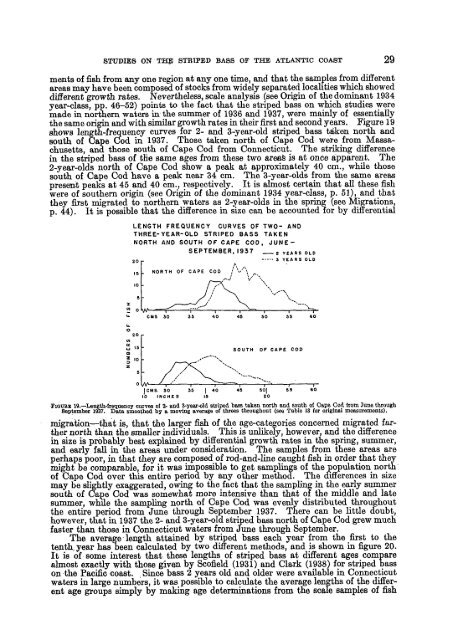Fishery bulletin of the Fish and Wildlife Service - NOAA
Fishery bulletin of the Fish and Wildlife Service - NOAA
Fishery bulletin of the Fish and Wildlife Service - NOAA
You also want an ePaper? Increase the reach of your titles
YUMPU automatically turns print PDFs into web optimized ePapers that Google loves.
STUDIES ON THE STRIPED BASS OF THE ATLANTIC COAST 29<br />
ments <strong>of</strong> fish from any one region at any one time, <strong>and</strong> that <strong>the</strong> samples from different<br />
areas may have been composed <strong>of</strong> stocks from widely separated localities which showed<br />
different growth rates. Never<strong>the</strong>less, scale analysis (see Origin <strong>of</strong> <strong>the</strong> dominant 1934<br />
year-class, pp. 46-52) points to <strong>the</strong> fact that <strong>the</strong> striped bass on which studies were<br />
made in nor<strong>the</strong>rn waters in <strong>the</strong> summer <strong>of</strong> 1936 <strong>and</strong> 1937, were mainly <strong>of</strong> essentially<br />
<strong>the</strong> same origin <strong>and</strong> with similar growth rates in <strong>the</strong>ir first <strong>and</strong> second years. Figure 19<br />
shows length-frequency curves for 2- <strong>and</strong> 3-year-old striped bass taken north <strong>and</strong><br />
south <strong>of</strong> Cape Cod in 1937. Those taken north <strong>of</strong> Cape Cod were from Massachusetts,<br />
<strong>and</strong> those south <strong>of</strong> Cape Cod from Connecticut. The striking difference<br />
in <strong>the</strong> striped bass <strong>of</strong> <strong>the</strong> same ages from <strong>the</strong>se two areafe is at once apparent. The<br />
2-year-olds north <strong>of</strong> Cape Cod show a peak at approximately 40 cm., while those<br />
south <strong>of</strong> Cape Cod have a peak near 34 cm. The 3-year-olds from <strong>the</strong> same areas<br />
present peaks at 45 <strong>and</strong> 40 cm., respectively. It is almost certain that all <strong>the</strong>se fish<br />
were <strong>of</strong> sou<strong>the</strong>rn origin (see Origin <strong>of</strong> <strong>the</strong> dominant 1934 year-class, p. 51), <strong>and</strong> that<br />
<strong>the</strong>y first migrated to nor<strong>the</strong>rn waters as 2-year-olds in <strong>the</strong> spring (see Migrations,<br />
p. 44). It is possible that <strong>the</strong> difference hi size can be accounted for by differential<br />
LENGTH FREQUENCY CURVES OF TWO- AND<br />
THREE-YEAR-OLD STRIPED BASS TAKEN<br />
NORTH AND SOUTH OF CAPE COO, JUNE-<br />
SEPTEMBER, 1937 г YEARS OLD<br />
го<br />
10<br />
9<br />
I<br />
и о<br />
NORTH OF CAPE COD<br />
|CHS SO<br />
10 INCHES<br />
3 YEARS OLD<br />
39 40 49 90 59 £0<br />
I<br />
15<br />
SOUTH OF CAPE COD<br />
PIQUEZ 19.—Length-frequency curves <strong>of</strong> 2- <strong>and</strong> 3-year-old striped bass taken north <strong>and</strong> south <strong>of</strong> Cape Cod from June through<br />
September 1937. Data smoo<strong>the</strong>d by a moving average <strong>of</strong> threes throughout (see Table 13 for original measurements).<br />
migration—that is, that <strong>the</strong> larger fish <strong>of</strong> <strong>the</strong> age-categories concerned migrated far<strong>the</strong>r<br />
north than <strong>the</strong> smaller individuals. This is unlikely, however, <strong>and</strong> <strong>the</strong> difference<br />
in size is probably best explained by differential growth rates in <strong>the</strong> spring, summer,<br />
<strong>and</strong> early fall in <strong>the</strong> areas under consideration. The samples from <strong>the</strong>se areas are<br />
perhaps poor, in that <strong>the</strong>y are composed <strong>of</strong> rod-<strong>and</strong>-line caught fish in order that <strong>the</strong>y<br />
might be comparable, for it was impossible to get samplings <strong>of</strong> <strong>the</strong> population north<br />
<strong>of</strong> Cape Cod over this entire period by any o<strong>the</strong>r method. The differences in size<br />
may be slightly exaggerated, owing to <strong>the</strong> fact that <strong>the</strong> sampling in <strong>the</strong> early summer<br />
south <strong>of</strong> Cape Cod was somewhat more intensive than that oi <strong>the</strong> middle <strong>and</strong> late<br />
summer, while <strong>the</strong> sampling north <strong>of</strong> Cape Cod was evenly distributed throughout<br />
<strong>the</strong> entire period from June through September 1937. There can be little doubt,<br />
however, that in 1937 <strong>the</strong> 2- <strong>and</strong> 3-year-old striped bass north <strong>of</strong> Cape Cod grew much<br />
faster than those in Connecticut waters from June through September.<br />
The average length attained by striped bass each year from <strong>the</strong> first to <strong>the</strong><br />
tenth, year has been calculated by two different methods, <strong>and</strong> is shown in figure 20.<br />
It is <strong>of</strong> some interest that <strong>the</strong>se lengths <strong>of</strong> striped bass at different ages compare<br />
almost exactly with those given by Sc<strong>of</strong>ield (1931) <strong>and</strong> Clark (1938) for striped bass<br />
on <strong>the</strong> Pacific coast. Since bass 2 years old <strong>and</strong> older were available in Connecticut<br />
waters in large numbers, it was possible to calculate <strong>the</strong> average lengths <strong>of</strong> <strong>the</strong> different<br />
age groups simply by making age determinations from <strong>the</strong> scale samples <strong>of</strong> fish<br />
50|<br />
20

















